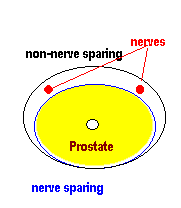 Radical Prostatectomy, surgery for prostate cancer, is used when there is a reasonable likelihood of curing the disease. It is used in younger, healthy patients with Stage A, Stage B, and some surgeons believe in some early Stage C prostate cancers. Surgical treatment also has better results in patients with high grade, (Gleason 8, 9 and 10), than does radiation, Although there are some data suggesting the combination of neoadjuvant therapy, external beam irradiation, brachytherapy , (seeds), and long term hormonal therapy may offer benefit to patients with these ominous high grade tumors. Surgery is uncommonly done for patients age 70 and over, as the gain in benefit does not counterbalance the increased risk. The operation is usually done through a lower abdominal incision, although some surgeons prefer the perineal approach, where the incision is made between the scrotum and rectum. A small number of surgeons can do radical prostatectomies through a laparoscope, or a surgical robot.
Radical Prostatectomy, surgery for prostate cancer, is used when there is a reasonable likelihood of curing the disease. It is used in younger, healthy patients with Stage A, Stage B, and some surgeons believe in some early Stage C prostate cancers. Surgical treatment also has better results in patients with high grade, (Gleason 8, 9 and 10), than does radiation, Although there are some data suggesting the combination of neoadjuvant therapy, external beam irradiation, brachytherapy , (seeds), and long term hormonal therapy may offer benefit to patients with these ominous high grade tumors. Surgery is uncommonly done for patients age 70 and over, as the gain in benefit does not counterbalance the increased risk. The operation is usually done through a lower abdominal incision, although some surgeons prefer the perineal approach, where the incision is made between the scrotum and rectum. A small number of surgeons can do radical prostatectomies through a laparoscope, or a surgical robot.
The operation involves removing the entire prostate, the seminal vesicles, (the organs that produce seminal fluid and are attached to the prostate), and reconnecting the bladder to the urethra, so that the patient may void normally. The open operations take 2 to 4 hours and require a 3 to 5 day hospital stay. When the procedures is done through a laparoscope, (belly button surgery), the procedures takes a significantly longer time, but the hospital stay is often reduced to a day or so. At the present time there are only a few surgeons in the US skilled in this procedure.
The advantage of surgical treatment is that the cancer is removed from the body. The disadvantages may include impotence, the inability to get or sustain an erection. . Other post operative problems may include incontinence, the inability to control urine after the surgery, (may be temporary or permanent), loss of ejaculation and fertility, and the other complications of surgery. However, the best long term cures are seen after surgical treatment for prostate cancer.
There are two variations major variations in the operation, nerve-sparing and non nerve sparing. The nerves that supply the penis for erectile function run along the sides of the prostate.
 In the standard, non-nerve sparing operation, the surgeon cuts widely around the prostate, including the nerves in the removed portion, thereby getting further out from the prostate and cancer, improving the chances of removing all the cancer. In the nerve sparing operation, the surgeon, in an attempt to preserve natural potency, cuts much closer to the prostate. A few surgeons around the country are replacing the native nerves with nerve grafts from the foot, with some improvement in post operative erectile function
In the standard, non-nerve sparing operation, the surgeon cuts widely around the prostate, including the nerves in the removed portion, thereby getting further out from the prostate and cancer, improving the chances of removing all the cancer. In the nerve sparing operation, the surgeon, in an attempt to preserve natural potency, cuts much closer to the prostate. A few surgeons around the country are replacing the native nerves with nerve grafts from the foot, with some improvement in post operative erectile function
Even with the nerve sparing operation, potency is frequently decreased. The preservation of erection is better in younger, healthier patients with good potency before surgery. Preservation of potency decreases with increasing age and associated conditions such as diabetes or hhypertension. Erectile ability may take up to two years to achieve maximal improvement. Frequent stimulation plus long term use of Viagra may be helpful in improving erection.
Fortunately, post operative erections can frequently be restored with drugs like Viagra or PGE-1 after either form of radical prostatectomy. Some patients will need a penile implant.
Incontinence, or loss of urinary control is another problem seen sometimes after radical prostatectomy. It is common immediately after surgery, and although usually temporary, and frequently mild, it may take months or years to resolve, and in a few patients be a persistent problem. Exercises, rehabilitative services and occasionally surgery to control incontinence are sometimes required.
You can contact our doctors and schedule an appointment if you want to know what option is right for you.
